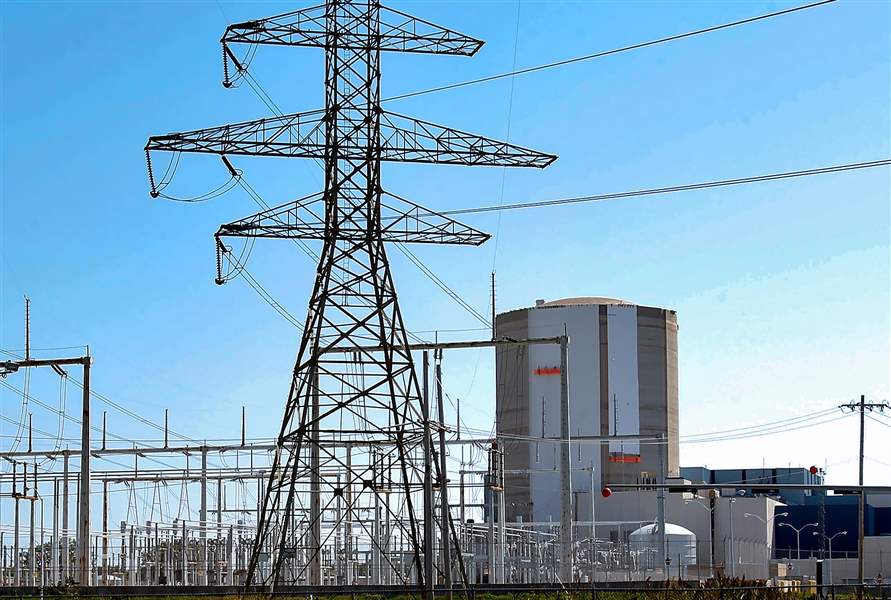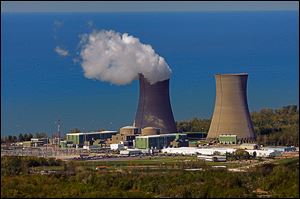
FirstEnergy plans to keep plants online
Jobs safe for now as fracking boom builds
11/10/2013
FirstEnergy Corp. remains committed to replacing the Davis-Besse plant’s original pair of steam generators with two new ones in the spring.
THE BLADE
Buy This Image

FirstEnergy Corp. remains committed to replacing the Davis-Besse plant’s original pair of steam generators with two new ones in the spring.
OAK HARBOR, Ohio — If today’s global fracking frenzy had kicked into high gear a decade ago, thousands of jobs at FirstEnergy Corp.’s Davis-Besse, Perry, and Beaver Valley 1 and 2 nuclear plants in northern Ohio and western Pennsylvania could have been imperiled by now.
“That’s fair to say,” Jennifer Young, FirstEnergy spokesman, said.
While job security at those massive power-generation stations is never strong enough to put workers at ease — especially with economic pressures brought on by the natural gas boom jolting the nuclear industry — Ms. Young said the situation appears more stable for FirstEnergy’s holdings than it does for nuclear plants in other parts of the country.
The era of hydraulic fracturing, or “fracking,” of shale bedrock has caused a drop in natural gas prices, which has caused energy markets to react.
Much of the hype is based around the anticipated fracking over the next 25 to 30 years in the Marcellus and Utica shale regions of eastern Ohio and Pennsylvania, where vast amounts of previously trapped natural gas and oil are expected to be recovered. But according to the International Energy Agency, a fracking boom is expected to go well beyond North America and include Europe, China, and other parts of the world.
Fracking itself isn’t new; it has existed for decades. What’s new is a horizontal drilling technique that allows oil and gas companies to gain significantly more access.

At the Perry nuclear plant, east of Cleveland, FirstEnergy Corp. is moving ahead with plans to apply for a 20-year license extension in 2015. Perry’s license expires March 18, 2026.
The Nuclear Energy Institute, the industry’s Washington-based lobbying group, has expressed concerns about what the fracking frenzy and falling natural gas prices are doing to the industry globally.
In a Sept. 12 speech at the World Nuclear Association annual symposium in London, Richard Myers — the NEI’s vice president for policy development — told attendees that the closing of the Kewaunee nuclear plant in Wisconsin and the planned closing of the Vermont Yankee nuclear plant next year “raise legitimate questions” about whether the natural gas boom is having a chilling effect on the nuclear industry.
Kewaunee and Vermont Yankee are two plants that the nuclear institute believes are closing almost exclusively because of economics, not operations. Those announcements came this year with the closings of the Crystal River nuclear plant in Florida and the twin-reactor San Onofre nuclear complex in southern California — the largest number of U.S. nuclear plants taken out of production in years.
The long haul
FirstEnergy nuclear power plants are expected to remain online:
■ At Davis-Besse, east of Toledo, FirstEnergy Corp. is following through on its commitment to replace the plant’s original pair of steam generators with two new ones in the spring.
Having those parts made, delivered, and installed requires a $600 million investment — a sign that FirstEnergy is putting money into Davis-Besse for the long haul, Ms. Young said.
“You look at that investment, you know it’s going to be around,” said Todd Schneider, FirstEnergy’s director of external communications.
The Nuclear Regulatory Commission is deciding whether to grant a 20-year extension to Davis-Besse, which is licensed through April 22, 2017.
■ At Perry, east of Cleveland, FirstEnergy is moving forward with plans to apply for a 20-year license extension in 2015. Perry’s license expires March 18, 2026.
■ At Beaver Valley 1 and 2, west of Pittsburgh, operating licenses were extended for 20 years in 2009. Beaver Valley 1 is now licensed through Jan. 29, 2036. Beaver Valley 2 is now licensed through May 27, 2047.
FirstEnergy replaced Beaver Valley 1’s steam generator and reactor head in 2006. It is making plans to replace Beaver Valley 2’s steam generator and reactor head in 2017.
Steam generator replacement projects are typically the most expensive that utilities will do at about two-thirds of America’s nuclear plants, those with pressurized water reactors. The other third have reactors with a boiling-water design, which do not use steam generators.
FirstEnergy’s $600 million investment for new Davis-Besse steam generators is exceeded only by what the utility spent to put the plant’s issue of once-faulty reactor heads behind it.
Davis-Besse’s original reactor head nearly burst in 2002 because of acid leakage. And one that was brought in from a mothballed Michigan plant wore out faster than expected.
A new reactor head made from the nuclear industry’s premier alloy, Alloy 690, was installed in the fall 2011. That type of alloy was not the industry standard when the other two reactor heads were built.
Once the new steam generators are installed, FirstEnergy will have put what it believes will be Davis-Besse’s most expensive improvements behind it — assuming more issues do not arise elsewhere, such as with the cracks found in the exterior of the plant’s containment building in 2011. Nuclear Regulatory Commission engineers have said those cracks do not compromise that building’s structural integrity.
“We are in a good position when it comes to looking ahead,” Ms. Young said.
Nuclear waste
The biggest obstacle standing in the way of FirstEnergy’s attempt to have Davis-Besse’s license extended into 2037 appears to be a national issue, the continued uncertainty over what to do with the industry’s buildup of spent reactor fuel.
Congress passed a law more than 30 years ago requiring a single repository, but none has been built.
With Nevada’s Yucca Mountain no longer likely to be the site for long-term storage — it had been the sole one under consideration for years — the NRC is hosting a series of meetings to hear from the public on what potential environmental impacts could exist if the nation takes a decentralized approach and allows for more extended storage of spent nuclear fuel beyond the licensed operating life of commercial reactors.
The so-called “waste confidence” rule does not authorize extended storage but requires the NRC to gather thoughts about such a plan. Licensing for long-term storage on site will be handled separately.
The Toledo area will be asked to weigh in.
The NRC has scheduled a Dec. 2 meeting in Perrysburg to solicit comments from residents in this part of the country. That will be in addition to meetings in Illinois, California, and Minnesota. The meetings were supposed to have been held by now but were postponed because of the government shutdown. Locations and other details will be posted in the coming weeks on the NRC’s Web site, www.nrc.gov.
Written comments also are being accepted at the agency’s headquarters through Dec. 20.
Power output
Perry’s 1,275 megawatts is the most capacity in FirstEnergy’s fleet, Ms. Young said.
At full power, that’s roughly enough power for 1.3 million homes.
The standard rule of thumb is that every megawatt produces roughly enough electricity for 1,000 homes, although that ratio tends to be less during peak demand periods, such as when people are using their air conditioners a lot during summer.
Beaver Valley 2 has a capacity of 918 megawatts, followed by Beaver Valley 1’s 911 megawatts, Ms. Young said.
Davis-Besse’s current capacity is about 900 megawatts, she said.
FirstEnergy’s energy portfolio includes electricity generated by coal-fired power plants, followed by nuclear.
Competition from natural gas is one reason why it has shut down some of its older coal-fired power plants.
But Mr. Schneider said the larger reasons are tougher government regulations on carbon dioxide and other greenhouse gases associated with climate change. Coal-fired power is the nation’s No. 1 source of those pollutants.
Nuclear plants do not emit greenhouse gases, but significant amounts of carbon dioxide and other pollutants are released by the mining operations and energy used to create nuclear fuel for reactor cores. There are other ways nuclear plants contribute indirectly, such as in the massive production of concrete and steel used in the facilities, the transportation of parts, and eventual disposal of waste.
Like DTE Energy, which is seeking a license to build a Fermi 3 nuclear plant north of Monroe even though that’s unlikely to be its next project, FirstEnergy is studying the energy landscape to see if the market supports new construction of any type of plant.
“We’re not looking to build any new power generation facilities now,” Mr. Schneider said, explaining that FirstEnergy continues to have enough power despite shutting down some coal-fired plants.
He agreed, though, that the utility would have to take a hard look at natural gas if it sees a need for new construction. Natural gas would be one of the many options FirstEnergy would weigh. It does not have an application in with the NRC for a new nuclear plant.
“You look at the economics and gas is favorable right now. But we certainly don’t know how long that’s going to last,” Mr. Schneider said.
Collapse mode?
Reaction to the 2011 Fukushima disaster in Japan, with more news emerging about radioactivity in the Pacific Ocean, apparently hasn’t had the same effect on America energy markets as natural gas prices: The NEI said polling it had an outside contractor do this fall showed 82 percent of Americans still believe nuclear power has a future in this country. Sixty-nine percent said they favor it.
But Mark Cooper, senior fellow for economic analysis at Vermont Law School’s Institute for Energy and the Environment, told The Blade last week that the nuclear industry faces a rough road ahead and not just because of natural gas.
He said utilities, especially in the wind-rich Midwest, are turning more to wind power and other renewables.
Part of that’s because of state laws requiring more energy diversification. Ohio and Michigan are among many which now have them.
But part of it’s also because of advances in energy efficiency and energy storage, anything from more energy-efficient appliances and light bulbs that use less power to advances in batteries that can store more of the power generated by wind and solar — what Mr. Cooper described as an upcoming “revolution in [energy] storage.”
“The nuclear industry is in collapse mode,” he said.
An economic analysis Mr. Cooper did for Vermont Law School, consistently ranked by U.S. News & World Report as one of the nation’s top environmental law schools, showed Davis-Besse on a list of 12 nuclear plants most likely to shut down before their licenses expire.
Perry and the two Beaver Valley plants were not on that list, although Perry was one of 38 plants that had four or more of the 11 risk factors in Mr. Cooper’s report.
The study did not attempt to rank the plants in the order they might close, or predict their closure dates.
It factored in competition from natural gas, as well as post-Fukushima regulations, rising costs of general operations, repairs, and the age of each facility.
“They’re old,” Mr. Cooper said. “They’re not free to operate.”
Contact Tom Henry at: thenry@theblade.com or 419-724-6079.